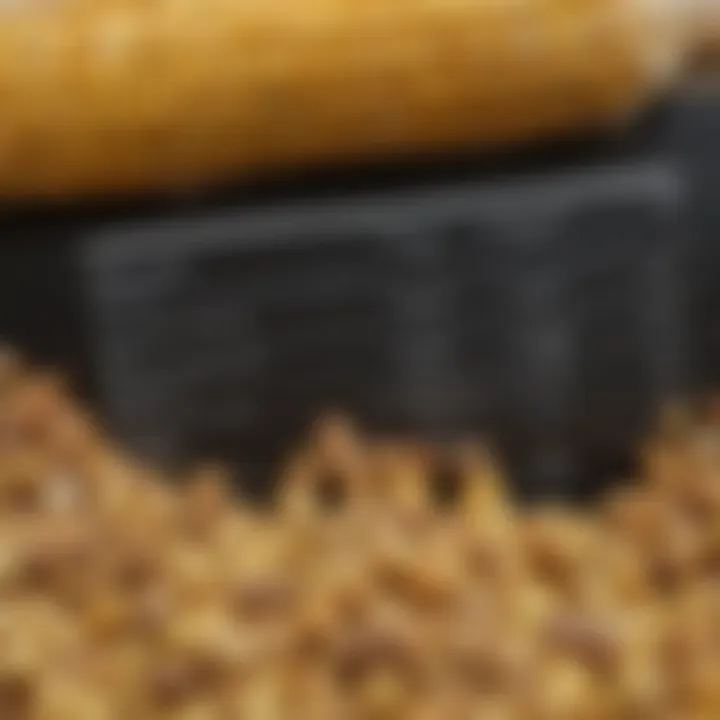Exploring Glutinous Corn: A Detailed Insight


Intro
Glutinous corn, often referred to as sticky corn, has long been a staple in various cultures, particularly in Asia and Latin America. Unlike regular corn, glutinous corn possesses a unique genetic makeup that influences both its texture and taste. While this crop often gets overshadowed by its more common cousins, it offers rich flavors and diverse culinary applications.
This article aims to serve as a comprehensive guide, covering the various aspects of glutinous corn, from its cultivation practices to its nutritional benefits, as well as examining its socio-economic importance in different regions. We will explore the gem-like qualities of this crop, often celebrated in culinary traditions yet less understood in agricultural discussions.
By diving deeper into the nature of glutinous corn, readers can better appreciate not only its functionality in food but also its significance in the larger tapestry of agricultural and cultural heritage.
"Understanding glutinous corn is not just about recognizing its taste but embracing its journeys through generations and geography."
In the following sections, we will showcase key findings, methodologies behind research, and discussions around glutinous corn’s future potential.
Foreword to Glutinous Corn
Glutinous corn, a notable variety within the maize family, presents an intriguing subject worth exploring. This crop is distinguished by its unique sticky texture and sweet flavor, making it a favorite in various culinary traditions around the globe. But there's more beneath the surface of this seemingly simple grain. Understanding glutinous corn is essential not only for food enthusiasts but also for researchers and agricultural professionals. Its multifaceted nature holds insights into genetics, cultivation practices, and its socio-economic significance.
Definition and Characteristics
Glutinous corn, often referred to as sticky or sweet corn, differs significantly from conventional corn types. The main distinction lies in its genetic composition, where the endosperm contains a higher amount of amylopectin—a type of starch—resulting in the characteristic sticky quality when cooked. This unique quality makes it ideal for various dishes, especially in Asian cuisines. The kernels are often white or yellow and maintain a sweet flavor that sets them apart.
Some defining characteristics include:
- Moisture Content: High moisture levels are typical, contributing to a tender result when cooked.
- Flavor Profile: The flavor is sweeter compared to field corn, enhancing its appeal in both sweet and savory dishes.
- Seed Varieties: Within glutinous corn, there exist diverse varieties tailored to specific climates and uses, from dessert items to savory dishes.
"Glutinous corn isn’t just a crop; it’s a cultural cornerstone in various regions, often tied to heritage and tradition."
Historical Background
The journey of glutinous corn starts several centuries ago, with evidence tracing back to ancient Mesoamerican civilizations that cultivated maize for sustenance and ritualistic purposes. The transformative journey of corn from wild grass to a staple food item showcases human ingenuity in agriculture.
In Asia, especially in countries like Thailand, Indonesia, and the Philippines, glutinous corn continues to thrive. Historical accounts indicate that these populations embraced the crop due to its adaptability to the local climate and its nutritional benefits. Traditional methods of cultivation, passed down through generations, emphasize the crop’s enduring importance. Over time, glutinous corn's popularity expanded beyond its native regions, influencing cuisines worldwide.
Understanding the historical roots of glutinous corn not only highlights its significance as a food source but also uncovers the cultural practices surrounding its cultivation and consumption.
In summary, glutinous corn exists at the intersection of history, culture, and nutrition. As we dive deeper into the biological attributes and practical aspects of cultivation, it's essential to remember that this crop's story is still being written in today’s agricultural landscape.
Biological Attributes
Understanding the biological attributes of glutinous corn is crucial not just for agricultural practices but also for appreciating its role in culinary traditions and nutritional profiles. These attributes contribute significantly to how this crop interacts with its environment and how it is cultivated and utilized across the globe. In this section, we delve into two main aspects: genetic composition and growth adaptability.
Genetic Composition
Glutinous corn, often called waxy corn, exhibits a unique genetic makeup that sets it apart from other corn varieties. This uniqueness primarily lies in its amylopectin levels. Let's break that down a bit: glutinous corn has a higher percentage of this branched-chain starch which contributes to its glutinous texture, making it sticky when cooked. Unlike normal corn, which contains a balance of amylose and amylopectin, glutinous corn’s genetic structure favors the latter.
This specific genetic trait can be traced back historically to indigenous groups who cultivated it for various uses, and it has been preserved through generations. Modern breeding practices have further refined this genetic pool, aiming to enhance yield while maintaining its essential properties. For researchers, understanding the specific genes involved is vital; by analyzing these traits, scientists can work on improving varietal resilience against environmental stressors.
Just so you know, advances in genetic research can potentially lead to more productive strains that still maintain that beloved sticky quality, thus preserving the cultural and culinary significance of glutinous corn for future generations.
Growth Adaptability
Another striking feature of glutinous corn is its exceptional growth adaptability, which allows it to thrive in various environmental conditions. This attribute is largely influenced by its genetic background and the way it has been nurtured over centuries. Glutinous corn can flourish in regions with different soil types, moisture levels, and climate. Whether it’s the highlands of Southeast Asia or the valleys of South America, this resilient crop can find a way to establish itself.


Factors such as drought resistance and the ability to perform in less fertile soils make glutinous corn an attractive option for farmers. This crop can also adapt its growth to different planting times depending on local weather, making it a flexible player in agricultural systems.
"Glutinous corn's adaptability makes it a staple in diverse cultures, demonstrating how humanity’s needs shape agricultural practices around the world."
Farmers often appreciate this adaptability not just for their own food security but also for the economic benefits that come with growing a crop that can outlast tough seasons or unpredictable weather patterns.
In summary, understanding the biological attributes of glutinous corn provides valuable insights into its cultivation, history, and future possibilities in agriculture and beyond. Their specific genetic composition, paired with robust growth adaptability, paves the way for an appreciation that goes beyond mere sustenance; it encapsulates an entire culture and legacy.
Cultivation and Agricultural Practices
Cultivating glutinous corn necessitates attention to several pivotal practices that ensure the optimal growth, health, and yield of this unique crop. The agricultural methods used not only influence the quantity of corn produced but also its quality. From soil requirements to pest management, understanding these factors can greatly affect the success of glutinous corn farming.
Soil Requirements
When dealing with glutinous corn, the soil plays a starring role as the foundation of growth. This crop thrives in well-drained, fertile soils rich in organic matter. The ideal pH level for glutinous corn is between 5.8 and 7.0. Too acidic or too alkaline can lead to nutrient deficiencies and poor plant health. Clayey or sandy soils can be problematic as well, as they either retain too much water or dry out too quickly.
To enrich the soil and ensure excellent productivity, it’s advisable to conduct a soil test. This helps determine nutrient levels and enables farmers to amend the soil accordingly. Adding compost or well-rotted manure can significantly improve soil structure and nutrient content. Really, this is where the phrase "you reap what you sow" comes to life.
Irrigation Techniques
Watering practices can make or break a glutinous corn yield. While glutinous corn does not demand flooding like some other crops, it does need consistent moisture throughout its growing season. The use of efficient irrigation systems is critical, especially in regions where rainfall may be unpredictable.
Drip irrigation is a favored technique among many growers. It delivers water directly to the roots, reducing water wastage and ensuring that plants receive ample moisture. Alternatively, sprinkler systems can also be used effectively, particularly in larger fields, though they may lead to higher evaporation rates. It’s wise to monitor soil moisture levels regularly, allowing farmers to identify when to irrigate. Overwatering can lead to numerous challenges, such as root rot or other fungal diseases.
Pest and Disease Management
Keeping pests at bay is vital for maintaining high crop yields and quality. Glutinous corn is susceptible to various pests, including corn earworms and aphids. Integrated Pest Management (IPM) strategies are helpful for controlling these pests, utilizing methods that combine both prevention and active control measures. Utilizing resistant varieties of corn, crop rotation, and introducing beneficial insects can create a balanced ecosystem in the cornfield.
Furthermore, monitoring your crop for early signs of disease is essential. Issues like fungal infections or bacterial wilt can creep in, affecting overall health. Regular scouting and maintaining proper air circulation among plants can mitigate many of these risks. In the words of an old farming adage, "an ounce of prevention is worth a pound of cure"—this is incredibly true for corn farming.
Remember, successful glutinous corn cultivation is not just about providing resources; it's about nurturing and understanding the needs of the crop.
By mastering soil management, irrigation practices, and pest control, farmers can harness the full potential of glutinous corn production. Each of these practices plays into the larger narrative of sustainable agriculture, combining tradition with modern innovations.
Nutritional Profile
Understanding the nutritional profile of glutinous corn is crucial for appreciating its role in diets across various cultures. This particular type of corn offers a mix of essential macro and micronutrients that contribute not only to physical health but also to overall well-being. The importance of this profile cannot be overstated, as it underscores the value of glutinous corn in both traditional practices and modern culinary explorations.
Macro and Micronutrients
Glutinous corn, often recognized for its sticky texture and sweet flavor, contains significant amounts of carbohydrates, making it a favorable energy source. However, its nutritional offerings extend beyond just calories. The following highlights these essential components:
- Carbohydrates: These serve as the primary energy source, crucial for maintaining daily activities. The complex carbohydrates found in glutinous corn help to fuel the body while providing longer-lasting energy compared to refined grains.
- Proteins: While not as high as other grains, glutinous corn does provide amino acids important for repairing tissues and producing enzymes and hormones. A diet incorporating glutinous corn can contribute positively to meeting protein needs.
- Fats: This type of corn is low in fat, which can be beneficial for individuals monitoring their fat intake.
- Vitamins: Rich in several B vitamins, such as folate and thiamine, glutinous corn supports energy metabolism and aids in forming red blood cells.
- Minerals: It also contains important minerals like magnesium and phosphorus, which play roles in bone health and various metabolic processes.
Thus, the balance of these macronutrients and vital micronutrients makes glutinous corn a valuable addition to diets, especially in communities where it forms a staple part of meals.
Health Benefits
The consumption of glutinous corn is tied to a variety of health benefits that can enhance one's quality of life. Here are some notable advantages:
- Energy Boost: Due to its high carbohydrate content, glutinous corn is an excellent option for those needing a quick energy boost, such as athletes or individuals engaging in physically demanding work.
- Digestive Health: Though its fiber content is different from non-glutinous corn, it still promotes digestive health by contributing to satiety and helping to regulate bowel movements.
- Nutrient-Rich: With its array of vitamins and minerals, glutinous corn can help meet daily nutritional requirements, which can be particularly beneficial for those with restricted diets.
- Potential Allergen-Free Option: For individuals with sensitivities to gluten, glutinous corn can serve as a suitable alternative, making it a favorable choice in gluten-free eating patterns.
"Incorporating glutinous corn into your meals can be both nutritious and delightful, offering a unique taste alongside essential health benefits."


The understanding of these nutrients and benefits paves the way for appreciating glutinous corn beyond its culinary uses. As more people discover its value, it holds promise for both personal well-being and cultural dishes worldwide.
Culinary Applications
The exploration of glutinous corn unfolds significantly in the kitchen. This crop’s unique properties lend themselves to an expansive array of culinary applications, which not only celebrate gastronomic heritage but also showcase glutinous corn in various modern contexts. Understanding these applications is paramount for appreciating the entire landscape of this crop’s cultural and nutritional relevance.
Traditional Dishes
In many cultures, glutinous corn holds a cherished place, often seen as the backbone of traditional meals. This ingredient features prominently in various regional dishes that reflect the history and customs of communities. For example, in many Southeast Asian countries, sticky rice, made from glutinous corn, is a staple. It’s commonly served during family gatherings, festivals, or special occasions, often paired with savory dishes or sweet desserts. The process of crafting these meals typically involves steaming or boiling the corn in banana leaves, which infuses additional flavors that are simply irresistible.
Some delectable dishes include:
- Khao Niew Mamuang (Mango Sticky Rice) – A popular Thai dessert featuring glutinous rice topped with fresh mango slices.
- Tamales – In parts of Mexico, glutinous corn masa is used to create these delicious parcels filled with various meats or vegetables and wrapped in corn husks.
In these culinary traditions, glutinous corn represents not merely a food item but a crucial element in shaping cultural identity. The sticky texture of the corn is not just a characteristic; it’s a bridge connecting generations through shared meals.
Modern Innovations
However, this beloved crop is not merely a relic of the past; it has found its way into contemporary cuisine as well. Popular chefs and home cooks alike are reimagining the use of glutinous corn, transforming traditional recipes into innovative dishes that appeal to modern palates. One noteworthy trend is the incorporation of glutinous corn into gluten-free products, allowing individuals with dietary restrictions to enjoy a broader range of foods. From pastries to sauces, glutinous corn starch acts as a binding agent, proving its versatility in creating textures that are similar to those of wheat-based foods.
Furthermore, modern health-conscious eating styles have seen a rise in using glutinous corn in bowls and salads, providing a hearty yet chewy texture that blends well with fresh ingredients. It can be featured in a refreshing summer salad combined with avocados, tomatoes, and a sprinkling of lime.
In essence, glutinous corn is a canvas for culinary creativity, adapting to the whims of chefs while still honoring its rich history.
Overall, the culinary applications of glutinous corn are vast and varied. From age-old recipes that connect cultures to cutting-edge innovations that cater to new dietary preferences, it remains a fascinating component of the global culinary landscape.
Cultural Significance
The cultural significance of glutinous corn extends far beyond its role as an agricultural product; it is woven into the very fabric of the communities that cultivate and consume it. This crop becomes a symbol of identity and tradition in many regions, serving as more than just food but as a medium through which cultural narratives are expressed. Each grain of glutinous corn carries with it a history, a story shared across generations, making its cultivation and usage a vital aspect of cultural heritage.
Regional Variations
Glutinous corn is grown in various regions, and its cultural importance varies distinctly across these landscapes. In Asia, for instance, it plays a crucial role in festive occasions and rituals. Here’s a closer look at some specific cases:
- Southeast Asia: In Thailand and Laos, sticky rice made from glutinous corn is a staple at celebrations and religious ceremonies. It often features in the traditional dish "khao niew," which is indispensable during festivals such as Songkran, where families gather to celebrate the Thai New Year.
- North America: Indigenous communities have been historically known to cultivate varieties of glutinous corn, using it in traditional dishes like tamales or corn pudding. These dishes often go hand-in-hand with cultural gatherings and events, signifying a legacy that honors their ancestry.
- Latin America: Countries like Mexico use glutinous corn to create various dishes, which are integral to family celebrations and local festivals. The preparation of tamales de elote, for example, is often a communal activity, reflecting a rich tradition of shared labor and culinary art.
Due to these differing regional practices, glutinous corn serves as a uniting force, connecting people through shared customs and values while reflecting the diversity of cultural expressions surrounding food.
Festivals and Celebrations
Festivals revolving around glutinous corn highlight its importance well. These occasions are steeped in rituals, color, and community engagement. Notable examples include:
- Harvest Festivals: Many cultures host harvest festivals dedicated to corn, where glutinous corn takes center stage, symbolizing abundance and gratitude. Events are filled with communal meals, music, and dancing, fostering a sense of togetherness.
- Cultural Celebrations: Events such as Dia de los Muertos in Mexico incorporate traditional foods made from glutinous corn as offerings to honored ancestors. This practice not only reinforces familial bonds but also ensures cultural continuity through the generations.
- Religious Rituals: For some communities, rituals performed with glutinous corn are seen as acts of giving thanks to the earth. The crops are often blessed, and the first harvest may be specially dedicated to spiritual practices, reiterating the connection between agriculture and the divine.
"Food is not just sustenance; it encapsulates the spirit of a culture, telling stories that resonate with shared experiences and memories."
Therefore, the cultural significance of glutinous corn is vast and profound, symbolizing both community identity and connections to the past. Whether in the heart of a rural village or during a major urban festival, this crop continues to embody the values and traditions that shape countless lives.
Economic Implications
The economic implications of glutinous corn play a crucial role in understanding its relevance beyond just a food source. This section will shed light on critical aspects such as market demand and export potential that inform trade, agricultural investments, and economic sustainability.
Market Demand


The demand for glutinous corn has seen a notable uptick in recent years. This can largely be attributed to its culinary versatility and nutritional benefits. From traditional dishes to modern gastronomic innovations, glutinous corn finds its way into cuisines worldwide. Its sticky texture makes it an ideal ingredient for desserts, pastries, and even savory dishes, enticing both home cooks and professional chefs alike.
Additionally, the rising interest in health-conscious eating has spurred demand. Glutinous corn is often perceived as a healthier alternative to regular corn due to its higher fiber content and lower glycemic index, appealing to those looking for nutritious options. This has prompted local farmers and larger agricultural enterprises to increase cultivation efforts to keep pace with consumer trends.
- Glutinous corn is popular in:
- Southeast Asian cuisine (think sticky rice enriched with flavor).
- Latin American foods, where it’s used in tortillas and tamales.
- Ethnic markets that cater to diverse populations, further boosting local economies.
The economic landscape is influenced by shifts in consumer preferences, with farmers adapting their crops in response. Increased demand creates opportunities for agribusinesses to generate higher revenues, while providing job opportunities in rural areas, subsequently aiding local economies.
Export Potential
Export potential is another pillar supporting the economic implications of glutinous corn. Countries like Thailand, Vietnam, and the Philippines are known for their significant production of this crop and have developed robust export markets. The global appetite for glutinous corn has paved the way for these countries to expand their agricultural exports, opening doors to international markets.
Factors contributing to the export potential include:
- Diverse markets: There’s growing interest in glutinous corn products in global food markets, particularly in North America and Europe, where ethnic food trends are on the rise.
- Value-added products: Exporting not just the raw product but also processed goods, such as flavored snacks or ready-to-eat meals that incorporate glutinous corn.
- Trade agreements and tariffs: Favorable trade conditions can offer a competitive edge to exporting nations, increasing their market share in foreign markets.
Furthermore, the increasing awareness regarding sustainable farming practices boosts the appeal of glutinous corn exports. Countries that utilize ethical farming techniques attract consumers who are willing to pay a premium for products that are sustainably sourced. The economic future of glutinous corn, whether in local markets or on the global stage, seems promising, given its multifaceted benefits and growing consumer preference.
Future Perspectives
Looking ahead, glutinous corn stands at a crossroads of innovation and tradition. For researchers and farmers alike, understanding the developments in this crop's future is crucial, as it intertwines with food security, economic sustainability, and agricultural resilience. This section dives into two significant facets: genetic research and sustainability efforts.
Genetic Research
Advancements in genetic research can greatly enhance glutinous corn varieties, leading to crops that are more resistant to environmental stresses, pests, and diseases. By harnessing techniques like CRISPR and genome sequencing, scientists are identifying specific traits that can be replicated or enhanced. This could translate into stronger yield potentials and improved quality of the grain itself.
A prime example is the focus on drought resistance. As water scarcity becomes more common, creating strains of glutinous corn that thrive under low-water conditions is vital. This not only preserves the crop but also supports farmers' livelihoods in increasingly challenging climatic conditions. Furthermore, research into the nutritional aspects of glutinous corn may uncover new health benefits, making it an even more attractive option for health-conscious consumers.
In parallel, collaboration between agricultural institutions, universities, and the private sector is essential. Sharing knowledge and resources can accelerate the pace of discovery and implementation. Genetic research could lead to a deeper understanding of local varieties and their unique characteristics, fostering practices that celebrate biodiversity.
Sustainability Efforts
In an era where sustainability isn't just a trend but a necessity, the agricultural practices surrounding glutinous corn must evolve. Sustainability efforts encompass a range of strategies from eco-friendly farming to nutrient cycling and beyond.
- Soil Health: Maintaining soil health is paramount. Practices like crop rotation, cover cropping, and organic amendments enrich the soil, ensuring that it remains fertile for future planting. Healthy soil leads to more resilient crops that can withstand pests and diseases better.
- Water Management: Efficient irrigation methods, such as drip irrigation or rainwater harvesting, can significantly reduce wastage and enhance the crop's resilience against climate variability. This aligns not only with conserving precious water resources but also with maximizing productivity.
- Community Engagement: Education plays a significant role in sustainability. Farmers should be informed of sustainable practices and the long-term benefits they bring. When communities come together to share insights and challenges, they create a robust network that supports the adoption of sustainable methods.
"Sustainability isn't just about doing less harm; it's about doing more good."
As these sustainability efforts take root, glutinous corn can become a model for eco-friendly agriculture. This not only helps the farmers today but ensures that future generations can also benefit from this unique crop. By investing in research and sustainability, the future of glutinous corn shines brighter, promising a harmonious blending of tradition with cutting-edge advancements.
Culmination
The importance of concluding this article on glutinous corn cannot be overstated. As we have explored, glutinous corn is not merely a crop; it embodies a rich tapestry of nutritional significance, culinary versatility, and cultural identity. By wrapping up with a summary of key points, it reinforces the multifaceted role this crop plays, prompting further dialogue among students, researchers, and industry professionals.
Summary of Key Points
- Definition and Characteristics: We delved into the unique features of glutinous corn, noting its sticky texture and high amylopectin content.
- Historical Context: Understanding the origins of this crop provides valuable insight into how it shaped various culinary traditions.
- Biological Aspects: The genetic makeup and growth adaptability of glutinous corn clarify why it prospers in diverse climates.
- Agricultural Practices: Recognizing the soil, irrigation, and pest management requirements allows for informed cultivation approaches.
- Nutritional Profile: The macro and micronutrient content of glutinous corn supports discussions on its contribution to healthy diets.
- Culinary Uses: From traditional dishes to modern innovations, the flexibility of glutinous corn in meals showcases its essential role in various cuisines.
- Cultural Significance: Festivals and regional variations highlight the profound connection between glutinous corn and cultural practices.
- Economic Potential: Analyzing market demand and export prospects underscores its significance in global agriculture and food industries.
- Future Perspectives: Genetic research and sustainability efforts open new avenues for advancements in the cultivation and utility of glutinous corn.
Final Thoughts
In closing, exploring the dimensions of glutinous corn reveals its immense potential and relevance in today’s world. Its versatile applications and cultural significance enrich both local traditions and global markets. Responding to market needs and evolving consumer preferences can shape the future of glutinous corn production. For anyone engaged in agricultural studies, culinary arts, or economic development, glutinous corn deserves a place at the table.
As we look ahead, fostering interest in this unique crop is vital for educational outreach, developing innovative farming practices, and sustaining culinary heritage. The dialogue surrounding glutinous corn is just beginning; its journey offers an abundance of knowledge for those ready to delve into its rich narrative.
"The future of glutinous corn lies not just in its cultivation, but in the stories it has to tell about nutrition, culture, and sustainability."
Exploring the many facets of glutinous corn encourages an appreciation for a crop that is as nourishing as it is significant. Whether on the dining table or in the field, its past, present, and future are intertwined, holding promise for generations to come.



